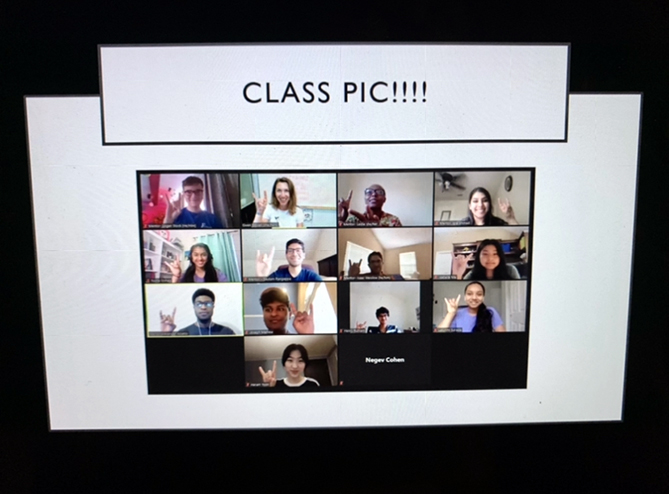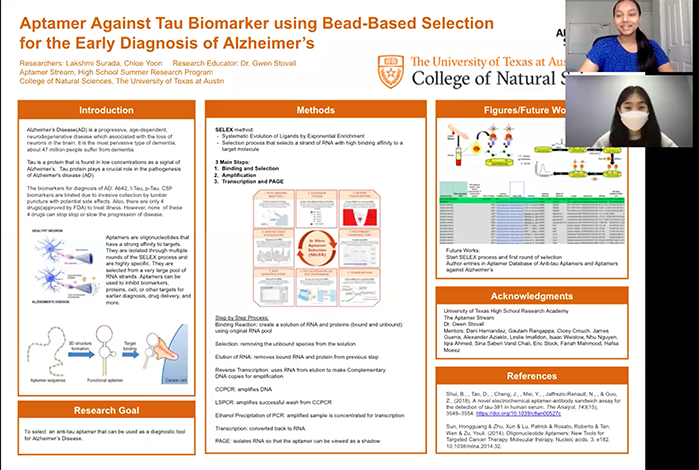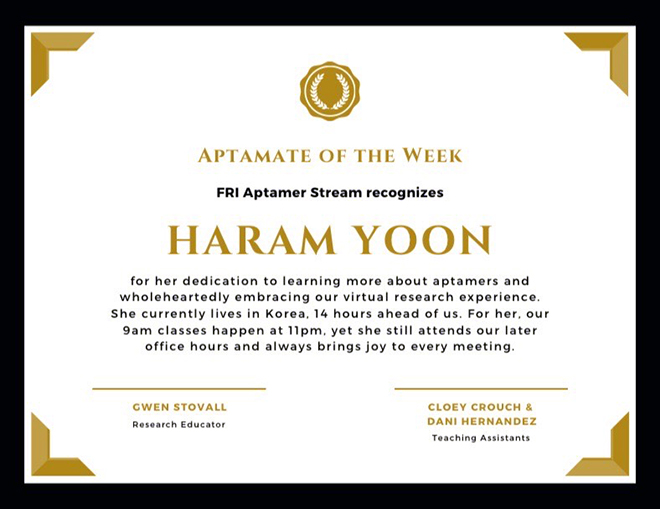From June 1st to July 9th, the University of Texas at Austin, the College of Natural Science, held an online research program for high school students. Through an application essay and my interest field, I was accepted to an Aptamer stream, biochemistry and immunology. I wanted to work at the lab in person; however, due to continuing limits to the number of people on campus and in the lab spaces, a high school research academy was held as an online experience.

Every Monday-Large group meeting, Wednesday-Database meeting, and Thursday-Small group HSRA meeting for five weeks, we worked with mentors, 1st-year remote researchers, and Dr. Stovall, an assistant professor of practice, freshman research initiative director, and High school research initiative. In the first week, we learned the concept of the Aptamers step by step. Aptamers are oligonucleotide or peptide molecules that bind to a specific target molecule. Simply put, aptamers are single-stranded DNA or RNA which have an affinity to bind to specific targets.
Every Large group meeting on Mondays, we began to learn about biochemistry. From the SELEX process to immunology, we expanded our knowledge. Also, after a short lesson, we listened to the 1st year researchers’ presentation from the third week. Various research topics related to aptamer surprised me, and I became more interested in it. By giving feedback to the presenters, I learned how to make great looking and effective PowerPoint and figured out that I am interested in aptamer research which can contribute to the field of Alzheimer's Disease.
On Wednesday’s database meeting, mentor Dani introduced the Aptamer Database project that they were working on. It is an aggregation, long-term preservation, and storage of aptamer research, and they had over 14,000 databases related to the aptamer. Learning from sequence and pool type to the affinity and binding buffer, we practiced finding the right paper from PubMed and extracting the right information for the database. The most challenging and time-required process was to find the right papers for the database. A lot of them were already included in the database, and there were various types of research in PubMed. I tried to find a paper from 2021 to avoid duplication. I put five papers on the google spreadsheet. After peer-reviewing from other researchers, I made one entry on the aptamer database!
Every Thursday, a small group meeting for high school researchers was held. We started learning from the buffer solution. Thursday, I took this time to fill in the knowledge, think about topics for the poster project with my teammate Lakshmi, and ask my mentors some questions. I could also listen to the detailed explanation about diagnostic applications such as tagging antibodies used in Elisa, Enzyme linked Oligonucleotide Assay (ELONA), and therapeutic aptamers from Dr. Stovall.

For the HSRA forum and large group meeting, Lakshmi and I worked together to make a poster as we were both interested in Alzheimer’s Disease. Our poster topic was to find an aptamer against tau biomarkers using Bead-Based selection for the early diagnosis of Alzheimer’s. Based on what we learned so far, we set a target and planned an experiment. Although we couldn't proceed with the lab experiment, we planned to devise the experiment in detail through our research on Alzheimer’s disease and the SELEX process.
It was more rewarding for me because we were the only team to make posters and presentations. Through the process of designing research and practicing presentations through Zoom conferences with the time difference between the U.S. and Korea, we realized that science was a vital field to play as a team, not as a single. Even with many difficulties, I learned a lot in five short weeks. Through preparing for the HSRA poster forum, I was able to explain our project, answer questions, and be sure of the knowledge I knew once more.

In the second week, I was recognized as an Aptamate of the week by mentors after all things considered. I think my attitude as an active learner contributed to this award: never missed the meeting nor showed up late, used the office hours run by mentors to reinforce my knowledge in biochemistry, and tried to answer all the questions diligently in the meetings. I was so proud of myself that the result came back as the recognition.
These five weeks of online research program became a remarkable and priceless experience for me. I was even distressed by the fact that I couldn’t be involved in any summer program because I’m staying in Korea due to Covid-19. When the situation gets better, I want to work at Dr. Stovall’s lab to conduct the experiment planned by us, and consequently wish to contribute to the research of the Aptamer stream. This opportunity of being involved in this summer high school online research program not only helped me grow as an individual but expanded my horizon as a whole. I would love to expand the global network in this field, learn new skills, help me to decide my future career, and take a step closer into my interest.

Haram Yoon
12th grade
Holy Trinity Catholic High School (TX)

